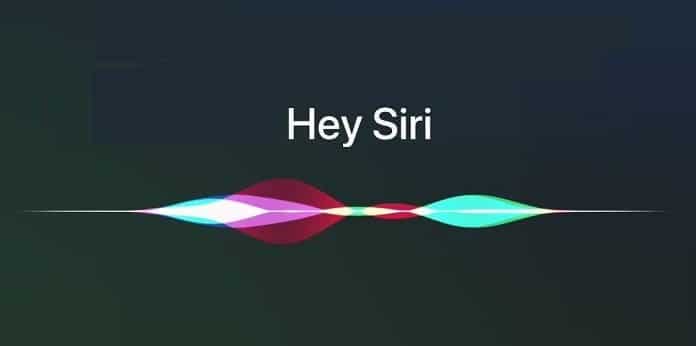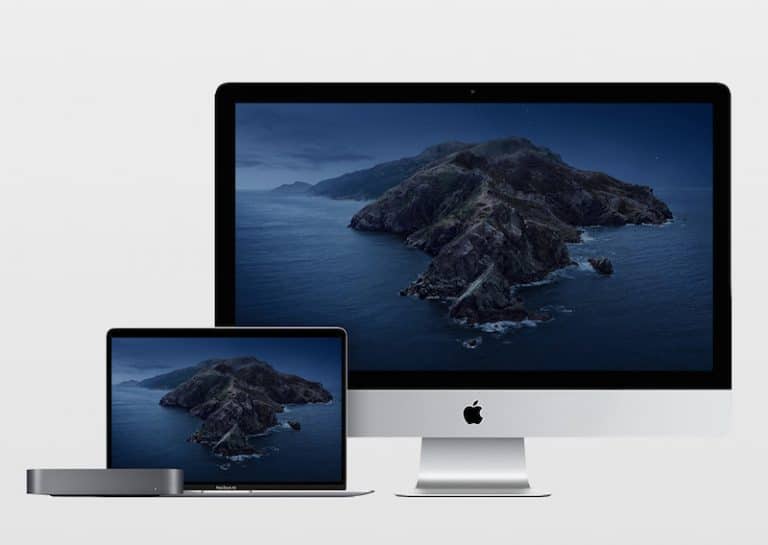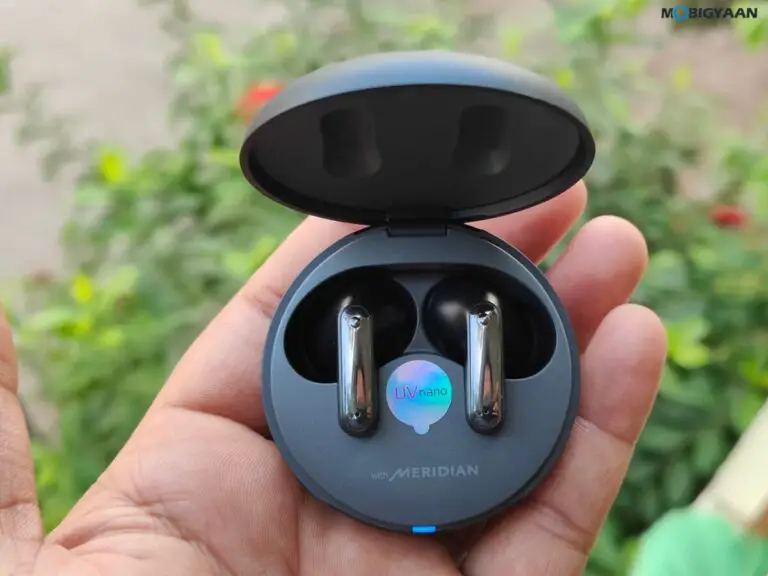Xiaomi Mi 10T Pro review: Simply terrific!
Xiaomi stepped a tad far out of its comfort zone earlier this year by launching a fully decked-out flagship - the Mi 10 Pro. However, the uncharacteristically high (for a Xiaomi phone) asking price put it squarely into a tier where the likes of Samsung and OnePlus reign supreme. Taking a step back, the Chinese giant launched the Mi 10T Pro a few weeks ago. The device is a specs monster, and despite making concessions in a few areas and shaving a big chunk off the price vis-a-vis the Mi 10 pair, it still sounds like a great package. In this review, we assess if the Mi 10T Pro is a return to form for Xiaomi as the company again raises its war cry for an all-out budget flagship contest.
Design

Mi 10T Pro is one big device, and there is no other way to put it.
Even for a person with fairly large hands, this phone will be quite a handful. And oh, it weighs 218 grams, so you'll definitely feel the heft in your denim pockets. The front, back as well as the rear camera module are all protected by a layer of Corning's Gorilla Glass 5. A glance down the specs sheet reveals that there is no IP-certification for dust and water resistance, which is worrisome.
The rear panel slopes alongside the edges and meets the frame without creating any sharp edges, and so does the front glass panel. The curvy profile provides a comfortable in-hand feel, but I found myself adjusting the phone every now and then in my hands as I tried reaching the upper half of the display. Despite its heft and generous dimensions, the build quality is top-notch through and through.
However, we have a couple of qualms, one of which you can see in the image below. The glossy rear panel, especially on the Cosmic Black variant we had for review, is a fingerprint magnet and quickly becomes a party venue for dust particles as well. I found myself obsessively cleaning the rear panel every time I chanced to look upon it. However, the almost mirror-like finish is quite an eye-candy.

If you are not a fan of all that shine and gloss, you will be better served by the Lunar Silver variant that flaunts a more understated matte finish on the rear panel. Xiaomi also sells an Aurora Blue trim that rocks a beautiful gradient finish, but it is only up for grabs in a few overseas markets. The second qualm I had with the device is its huge camera bump. It makes the device wobble and had me constantly worrying about scratching the camera lenses. Xiaomi bundles an anti-bacterial case in the retail package, which you should definitely put to use.
Overall, I think that the Mi 10T Pro is built well and doesn't look half bad either. But you should definitely visit a nearby Xiaomi store in person and check if the size and heft of the Mi 10T Pro are manageable for you.
Display

The large size of the Mi 10T Pro is somewhat of a red flag, but it also brings a perk too - a large display that is tailor-made for multimedia consumption. The added screen space ensures that on-screen controls in games are not cramped and watching a couple of Supernatural episodes was also a pleasing experience. And now that we're talking about the experience part, there is both good and bad news.
Let's address the elephant in the room here - the LCD panel on the Mi 10T Pro. With an asking price of € 549 (~ £ 549.99 / ₹ 39,999), the Mi 10T Pro falls straight into the premium segment - a bracket where you likely won't find a smartphone packing 'an inferior LCD' display as they all rock AMOLED panels. In its defense, Xiaomi noted that it thing an LCD panel since some users face visual issues while using an AMOLED display, which sounds like a reasonably inclusive move.
But from an average smartphone buyer's perspective who is willing to fork that amount, the 'AMOLED is better than LCD' concept will play a major deciding factor in actually buying the phone. But that's only half the story when it comes to the Mi 10T Pro's display attributes. Let's first see what the display has to offer:

Display quality is impressive
The color reproduction was good, viewing angles were satisfactory and thanks to a pixel density of almost 400ppi, on-screen content was sharp. Sunlight legibility was also up to the mark, but the colors definitely look a bit dimmer compared to an AMOLED display. This is, of course, due to the lower brightness output of the LCD panel compared to an AMOLED screen. I noticed that at low brightness levels, there was minimal backlight bleeding in the darker areas of the screen or subdued color contrast while playing games or watching videos.
Compared to an AMOLED display, I found out that the Mi 10T Pro's LCD panel offered a satisfactorily good contrast. The difference between the Mi 10T Pro's LCD panel vs the OnePlus 8's AMOLED display truly widened while viewing HDR content though. Additionally, the gap between brightness output becomes evident when using the Mi 10T Pro under direct sunlight. But as I mentioned earlier, you will only notice the trade-offs of an LCD display when you compare it against a well-tuned AMOLED display.
Among the best LCD screens on a phone out there
It goes without saying that colors on an AMOLED display are punchier and look more pleasing to the eyes. However, that doesn't always mean you see the natural colors, and the color separation can also be underwhelming if not tuned properly. I performed a few synthetic quality comparison tests and noticed that color separation in the banding and contrast tests was slightly better on the Mi 10T Pro's AMOLED display compared to a run-of-the-mill AMOLED panel. You can check more Mi 10T Pro display tests in this excellent XDA-Developers article to understand how good it actually is.

But the real ace here is the refresh rate, as the Mi 10T Pro's display offers a refresh rate of 144Hz, which is the highest you can get out there. Needless to say, everything from navigating the UI to doom-scrolling my Twitter feed appeared silky smooth. While the jump from 90Hz to 120Hz is claimed to be barely noticeable, I did notice a tangible difference in smoothness when I switched from using the Realme 7's 90Hz panel to the Mi 10T Pro's 144Hz display.
The smoothest screen I've used so far
When it comes to gaming, the high refresh rate is always a good thing to have for high fps gameplay. But there are not many games that support high fps gameplay, so you can't really take full advantage of the Mi 10T Pro's 144Hz screen. However, the device will be up to the job if the on-screen content's frame rate stands above the 60fps mark, thanks to a technology called AdaptiveSync.

Unlike the fixed refresh rate values (60Hz / 90Hz / 120Hz) on a lot of smartphones with an AMOLED panel, AdaptiveSync on the Mi 10T Pro allows the screen to automatically adjust the refresh rate (30Hz / 48Hz / 50Hz / 60Hz / 90Hz / 120Hz / 144Hz) based on the content you're watching. So, if you are watching a 60fps video, the screen refresh rate automatically goes into 120Hz mode to minimize any instances of tearing or artifacts, providing an eye-pleasing smooth visual experience.
However, there is certainly a crowd of potential buyers out there that would have appreciated an OLED panel with a lower 90Hz refresh rate compared to a 'sub-par' 144Hz LCD panel. I did compare the Mi 10T Pro's display against the 90Hz AMOLED panel on the pricier Mi 10, and it does look more vibrant and pleasing to the eyes. But on its own, the Mi 10T Pro's LCD display is fantastic.
Performance
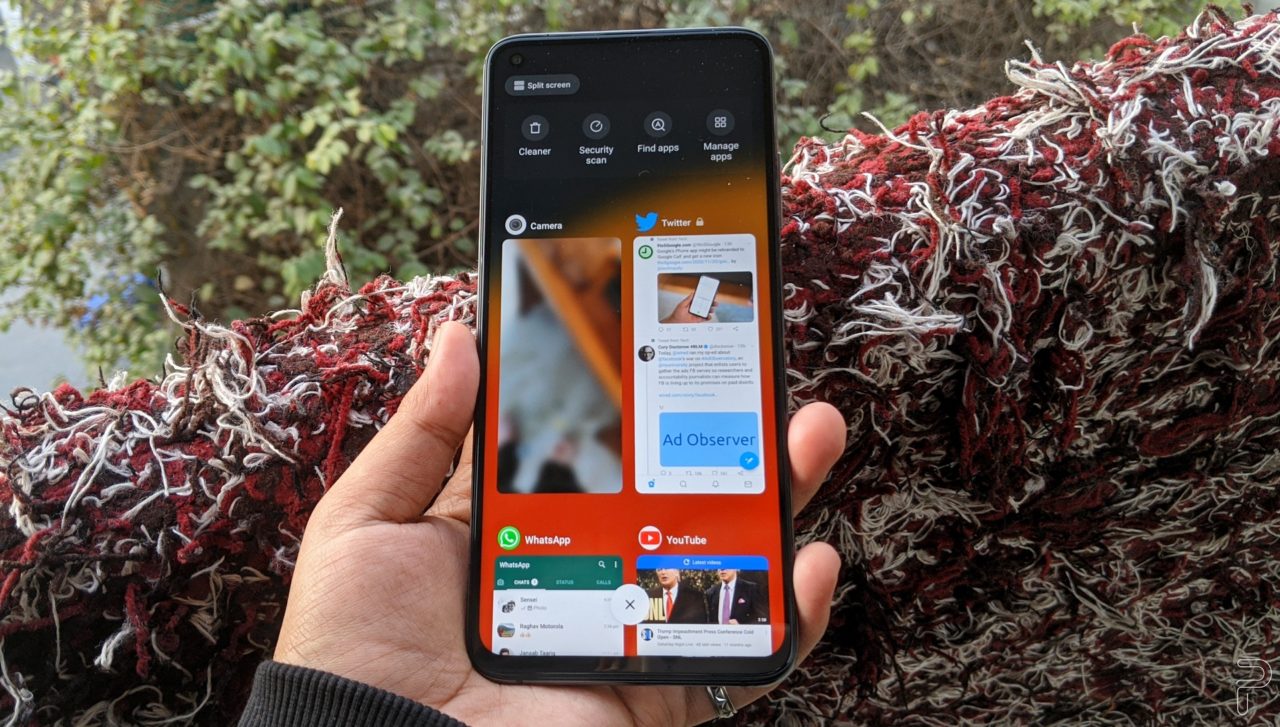
The Mi 10T Pro draws its firepower from Qualcomm's top-of-the-line 865 Snapdragon SoC that is paired with 8 gigs of LPDDR5 RAM and 128GB of fast UFS 3.1 storage. Here at Pocketnow, we aren't big fans of synthetic benchmarking scores, but it goes without saying that the Xiaomi offering sits right at the peak of the performance hill alongside other Snapdragon 865-powered phones.
There is plenty of RAM, which means you can run a lot of apps without worrying about the device killing tasks in the background. There is no microSD card expansion slot, so you have to make do with the onboard 128GB space.
In day-to-day usage, I found the app launch experience to be zippy, and there was no aggressive resource optimization in the background. Coming to the gaming part, the Mi 10T Pro absolutely crushes it, which is to be expected from a device that packs Qualcomm's flagship processor. But I was impressed to see that even after gaming sessions that lasted up to 30-40 minutes, there was almost no tangible throttling despite some heating in the upper region of the device.

The most enjoyable aspect of having a 144Hz display is that you can fully enjoy its perks in certain games that support high fps output. I played Vainglory, and using Gamebench, I recorded a steady frame rate of 144fps for almost 96 percent of my gaming sessions (with fps drops only happening on the load screen or animation in the middle of the actual gaming session).
On PUBG Mobile, I recorded a stable 60fps frame rate with even higher stability, which is quite impressive considering the fact that I played a few battle royale matches at Ultra HD graphics settings and frame rate set to Ultra. The only drawback is that there are not enough games to take advantage of that 144Hz display.
MIUI 12 is loaded with useful features and offers a thoroughly enjoyable user experience

I quite like the new look of MIUI with its v12 iteration. Yes, you will still come across a bunch of pre-installed apps such as Zilli, Booking.com, Mi Pay, Mi Credit, Themes, and GetApps to name a few. And yes, a few of them did push pesky notifications, but I restricted their notifications access and disabled ad permissions to get rid of the problem. I also noted that some user-submitted themes and wallpapers fudged up how thumbnails looked on social media apps when the system-wide dark mode was enabled. (See picture)
A neat touch in MIUI 12 is that you can swipe downwards anywhere on the screen to access the quick setting toggles and the notifications. The implementation is somewhat similar to iOS. You swipe downward in the left half to access the quick settings drawer, while doing so on the right side pulls the notifications tray. I loved that there is a native screen recorder tool, and you can also customize notifications behavior while playing games. Plus, I particularly liked how floating windows for messaging and social media apps have been implemented.
Another helpful feature is how app actions are handled. You just have to long-press on an app's card in the app switch overview to access controls such as split-screen, floating window, app settings, and preserving it from the background app kill command.
Camera

Now, let's talk about cameras. Xiaomi has armed the Mi 10T Pro with an optically stabilized 108MP (f / 1.69) primary camera that uses the 1 / 1.33-inch Samsung HMX sensor which relies on 4-in-1 pixel binning. It is accompanied by a 13-megapixel primary camera with a 123-degree field of view and a 5MP macro camera.
There is no telephoto camera for delivering some optical zoom magic, so you'll have to make do with the 30x digital zoom output of the primary camera. Talking about camera capabilities, the key highlights include support for 8K video capture, 4K at up to 60fps, slo-mo capture at up to 120fps, a dedicated vlog mode, AI SkyScaping 3.0 to name a few. Well, enough about on-paper power, let's talk about actual performance.
A dependable set of cameras with a ton of tricks
The pixel-binned shots captured by the 108MP main camera turned out sharp with good contrast, on-point colors, and sufficient dynamic range in well-lit conditions. I was particularly impressed by the portrait shots, which came out great with clean edge detection and a healthy amount of details. Xiaomi also appears to have worked on its color algorithm, as the pixel-binned shots reproduced close to natural colors, and did not turn out to be an oversaturated mess with bad control over highlights.


I'll definitely carry this camera for my next vacation!
As for the full-resolution 108MP photos, they are rich in detail, but they lose out on some dynamic range and look a tad anemic compared to the pixel-binned photos. On the bright side, you get a lot more detail while pixel peeping. Since there is no telephoto camera here, you'll have to rely on digital zoom that goes up to 30X. However, I found that details were intact only up to 3X zoom, and beyond that, edges started appearing blurry and finer elements began exhibiting a weird oil-painting effect with a fair bit of noise.
The 5MP (1.12μm pixel size, f / 2.4) macro camera is one of the Mi 10T Pro's key highlights. I've grown accustomed to smartphone makers throwing in a 2MP macro lens just for the sake of packing more cameras on their device, but the extra megapixels make a huge difference here. You can go as close as 2cm to the subject, and in most scenarios, the focus lock was spot on. Talking about actual quality, the macro shots turned out beautiful. The outlines are sharp, colors are vibrant and there is a sufficient amount of detail in the pictures.


Xiaomi markets the 108MP sensor, but this 5MP macro camera is the real star!
However, if you push too close to the subject and approach the minimum focal range, the colors often turn out a little darker with some peripheral blurring in tow, but this can primarily be attributed to the lens receiving a lesser amount of light. In any case, the details are still there and you can even clearly make out the microfibers on a fabric. Just make sure that you have steady hands while taking macro shots because locking the focus at close range can be a little finicky. I also wish that there was a quicker way to enable the macro mode, instead of opening the hamburger menu from the top and switching to the macro lens.
The 13MP ultra-wide-angle camera also captures useful photos. The wide shots are well-saturated with decent dynamic range. Fortunately, there is not much barrel distortion to be seen here, but certain objects such as vehicles tend to look flat if they are around the periphery of the frame.


In well-lit scenarios, I managed to capture some crisp photos that are Instagram-worthy. However, the wide camera struggled in challenging conditions. I clicked a few shots during evening time, and even though they look detailed, they are noticeably softer and details such as foliage and shadows are lost. If you compare images captured by the main and ultrawide cameras, you'll notice that the wide shots have a discernibly warmer temperature too.
Very good camera for night photography
There's also a dedicated night mode, and it returns impressive results. Notably, the Mi 10T Pro's camera automatically recognizes low-light scenarios and captures a long-exposure shot that can take anywhere between 2 and 4 seconds to process even without enabling the night mode. The results are, however, nothing to scoff at.
In very dim lit scenarios, I checked the EXIF data and noticed that the RGB color profile of photos captured by the night mode is almost thrice as wider than those clicked with normal mode. What this means is that the night mode extracted three times more colors in low-light scenarios.
Have a look at the low-light shots of this gate which was captured against a pitch-black sky, and notice the amount of surface detail it has retained. Also have a look at the picture of an old house on almost pitch black road:


To show you the difference that the night mode brings, have a look at the two photos below that were captured from the same spot:


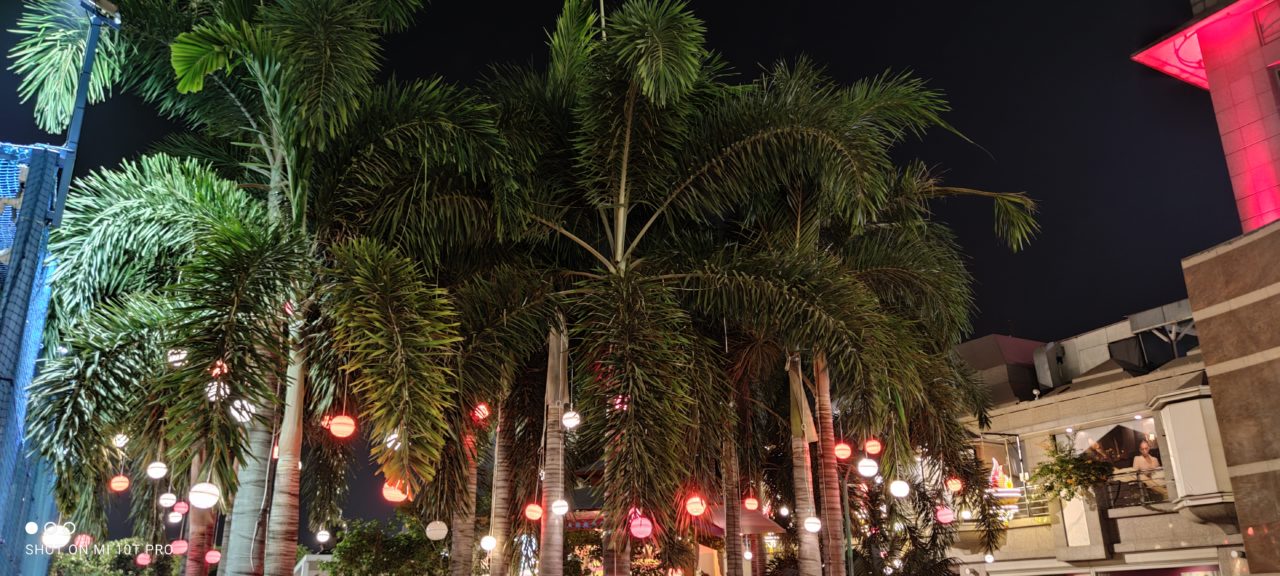

The results speak for themselves. Low-light photos are noticeably brighter with more colors and discernible objects. However, your mileage will vary depending on the amount of light around the subject. I've used all high-end devices launched by Xiaomi in the past couple of years, and I can confidently say that the Mi 10T Pro sits right alongside the much pricier Mi 10.
But there is still room for improvement. I compared the low-light output of the Mi 10T Pro against the Pixel 4a, and there is a noticeable difference in how the objects are exposed and minute surface details come out. Google has traditionally made much better use of its computational photography techniques, and that is one area where Xiaomi has to catch up for further enhancing the camera output of its smartphones.
This camera takes terrific portrait shots
Coming to portrait photography, the Mi 10T Pro takes stunning portrait shots. The subject separation is up to the mark, exposure is on point, edge detection is also good for the most part and colors are close to natural.
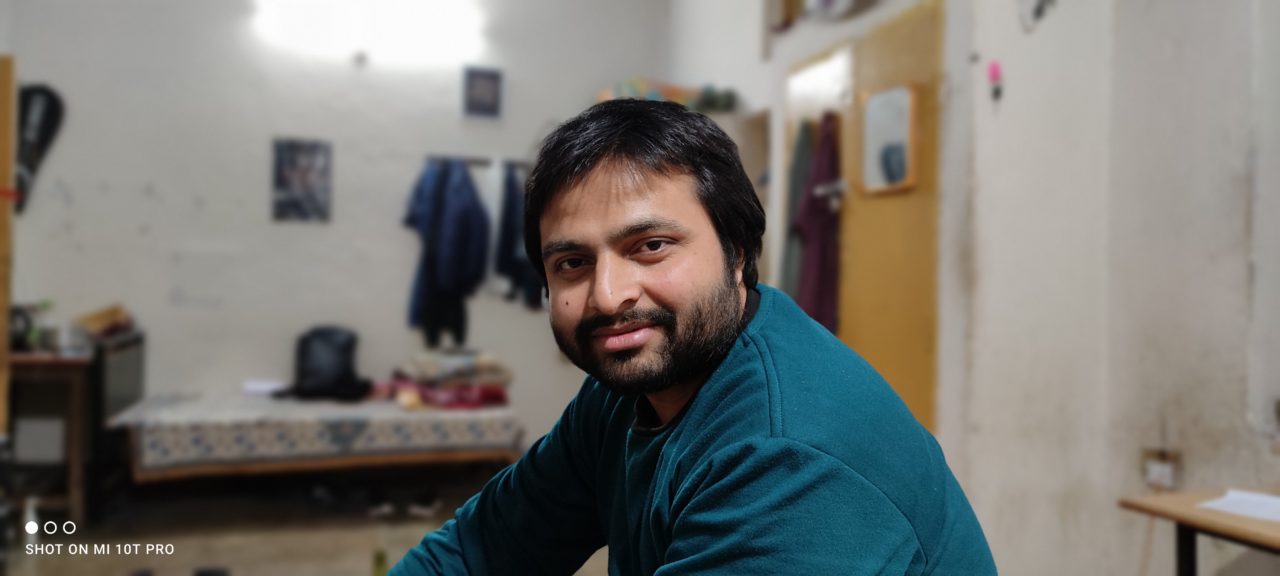
In well-lit conditions, the phone delivers consistently. In scenarios with challenging light, the phone occasionally fails with subject separation. For example, in the image below, you can see that the color and subject isolation are fine for a low-light shot, but the camera mistakenly blurred my entire hair.

Xiaomi has equipped the Mi 10T Pro with a 20MP (f / 2.2) front camera, and it captures great shots. I was thoroughly impressed by the amount of detail it captured in natural light. You get true-to-life skin tones with no aggressive beautification, and details such as blemishes and texture are preserved well. Portrait selfies also turn out great with a healthy amount of detail, good edge detection, and a natural bokeh effect. There are occasions where it falters with background elements caught between the subject's body and arms, but those are instances far and few.

A whole lotta filters and editing tools
And if you are into posting a lot of selfies on social media platforms, there are deep editing controls baked right into the gallery app. Plus, the filters work really well and some of the results actually turned out beautiful. There is a dedicated vlog mode as well which lets you record time-lapse videos tailor-made to be posted as stories. If you want to know more about the Mi 10T Pro's video performance, you can watch Pocketnow's review video below in which Joshua Vergara did a deep dive into the videography aspect:
Battery
The Xiaomi Mi 10T Pro comes equipped with a 5,000mAh battery that easily lasted me a full day of use with the refresh rate set to 144Hz and all day long internet connectivity. I watched almost two hours of video content each day, browsed through social media, answered my emails, listened to music over Bluetooth headphones for a couple of hours, and played games for around 40-50 mins each day.
Easily lasts a whole day, but no wireless charging
With the aforementioned use case, I ended the day with around 10-15% of juice still left in the tank. However, if you're not a heavy user like me, the Xiaomi Mi 10T Pro will easily last you a day and a half. Xiaomi bundles a 33W charger in the box which can charge the battery fully in about an hour. In an ideal condition, you can easily get up to 60% charge in around 25 minutes.
Notably, there is no wireless charging support, which is kind of a bummer. If the phone is running out of juice, there's an extreme battery saver mode that kills all background activity, a lot of unnecessary programs, and even disables 5G to save juice. You can also restrict background activity as well as notifications separately on a per-app basis, which definitely comes in handy.
Final words

I started testing the Mi 10T Pro with a more-critical-than-usual approach, primarily because I wanted to make sure whether this is just another spec beast, or if it actually lives up to the hype. For the most part, it lives up to the expectation, and with flying colors. The phone packs a beautiful 144Hz LCD display that didn't leave me wanting for an AMOLED panel. The software experience is much cleaner, intuitive and there are a ton of useful features in MIUI 12.
The camera setup is powerful and it delivers some good results. Plus, there are a ton of features to play with, and a majority of them actually work quite well. I particularly loved the selfie camera and sky mode. There is still some room for improvement when it comes to low-light photography, but there are no major shortcomings that could be called a red flag here. Battery life is also up to the mark and 33W fast charging is there to sweeten the experience.
Xioaomi has cut just about the right corners and delivers where it matters!
But the device is big, and that is something you should keep in mind before shelling out. And if the characteristic color profile of an AMOLED panel and wireless charging are two things you can't live without, you should look elsewhere (Read: OnePlus 8T and Samsung Galaxy S20 FE). The lack of an IP-certification is something that has me worried though. But overall, I think Xiaomi has done a good job and cut just about the right corners to create an excellent phone.

-
Although a tad big, Xiaomi Mi 10T Pro has a solid build and packs a gorgeous 144Hz AMOLED display. Performance is top-notch, and camera output is also impressive. MIUI 12 offers a polished and feature-rich experience, and battery life is great too. Lack of an AMOLED display and wireless charging might be a bummer for many, but the overall package is great for its asking price.

